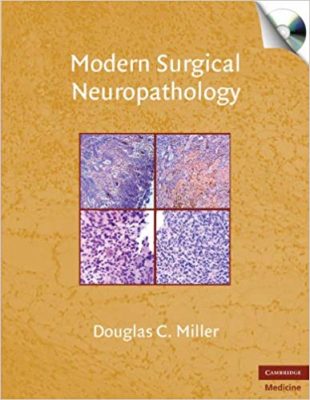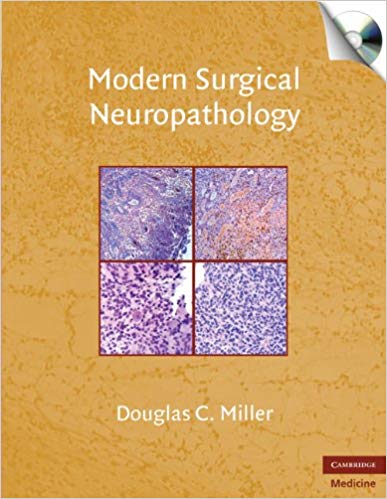 Author: Douglas C. Miller, MD
Author: Douglas C. Miller, MD
Publisher: Cambridge University Press–519 pages, with 1,200+ full-color photomicrographs
Book Review by: Nano Khilnani
The nervous system is the most complex organ system in the human body, and this may be reason why it is susceptible to large variety and range of diseases, Dr. Douglas Miller, the sole author of this highly informative text, states in his introductory note.
Much research in the field of neuropathology has been conducted in the past two decades, leading to better understanding of the causes of and treatment of diseases in the brain and within the vast network of nerves we all have.
This book was published in 2009, and just a decade earlier, brain tumors were an “automatic death sentence,” Dr. Miller writes. While much progress has been made in this medical specialty that has enabled the saving of more patients’ lives by neurosurgeons and neurologists, precision is a must in diagnosing neurologic disease.
“The pathologist plays an indispensable role in surgical diagnosis; he or she must accurately diagnose a potentially wide array of disease entities, determine the spread of disease within millimeters, and assess patient prognosis,” Dr. Miller cautions readers of this highly valuable book. Since neuroscience is such a precision-based field, we have laid out the entire contents of this book so that you won’t miss any part of any of the 44 chapters of this gem of a book:
- Introduction and Overview: Principles and Techniques
- Part I – Neoplasms
- Section I – Brain Neoplasms
- Subsection 1 – Intrinsic Brain Tumors
- Gliomas: An Overview
- Diffuse Fibrillary Astrocytomas
- Special Types of Astrocytomas
- Oligodendroglioma
- Mixed Gliomas
- Ependymomas
- Neuronal and Neuronal-Glial Tumors
- Primitive Neuroectodermal Tumors
- Primary CNS Lymphomas
- Primary CNS Germ Cell Neoplasms
- Hemangioblastoma
- Choroid Plexus Neoplasms and Miscellaneous Intracerebral Masses
- Metastatic Neoplasms in the Brain Parenchyma
- Subsection 2 – Extrinsic Brain Tumors
- Meningiomas
- Nonmeningioma Dural-Based Neoplasms
- Dura and Leptomeningeal Metastatic Cancer
- Tumors of Intracranial Peripheral Nerves
- Craniopharyngioma and Rathke’s Cleft Cysts
- Miscellaneous Meningeal Masses
- Pituitary Tumors
- Skull-Based Neoplasms
- Section 2 – Spinal Cord Neoplasms
- Subsection 1 – Intrinsic Spinal Cord Tumors
- Intrinsic Spinal Cord Tumors, I: Overview
- Ependymomas of the Spinal Cord
- Other Gliomas of the Spinal Cord
- Miscellaneous Cord Tumors
- Subsection 2 – Extrinsic Spinal Cord Neoplasms
- Meningiomas and Other Primary Dural-Based Tumors of the Spinal Cord
- Nerve Root Tumors
- Tumors of the Spine
- Part II – Nonneoplastic Mass Lesions
- Tumefactive Demyelinating Disease: Its Surgical Pathology and Differential Diagnosis
- Inflammatory Masses in the Brain Parenchyma
- Extraaxial Inflammatory / Infectious Lesions
- Biopsies of the Cerebral Infarcts
- Extraaxial Intracranial Hemorrhages
- Malformations of or in the CNS Parenchyma
- Part III – Diagnostic Brain Biopsies for Non-Neoplastic Disease
- Biopsies for Vasculitis
- Biopsies with / for Noninflammatory Vascular Diseases
- Biopsies for Diagnosis of Dementia
- Biopsies for Infectious Diseases
- Part IV – Surgical Neuropathology of Epilepsy
- Current Procedures Leading to Epilepsy Surgery: What the Neuropathologist Should Know about the Epilepsy Workup Prior to Surgery
- Abnormalities Probably Causing Epilepsy
- Effects of Epilepsy Manifest in Re-sected Brain Tissue
- Iatrogenic Lesions
- Special Syndromes and Epilepsy
This is a highly detailed and useful book for anyone aspiring to enter the field of neuropathology, and for established practitioners as well.
Author:
Douglas C. Miller, MD, PhD is Clinical Professor in Pathology and Anatomical Sciences at the University of Missouri School of Medicine in Columbia, Missouri. Previously Dr. Miller was Professor of Neuropathology and Neurosurgery at New York University Medical Center, where he was also Director of Neuropathology







